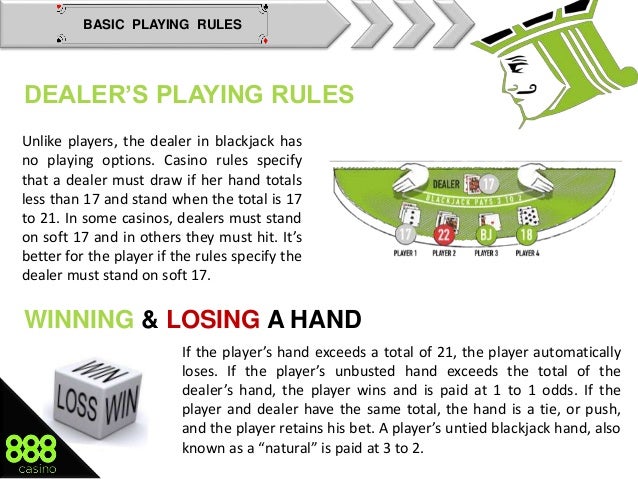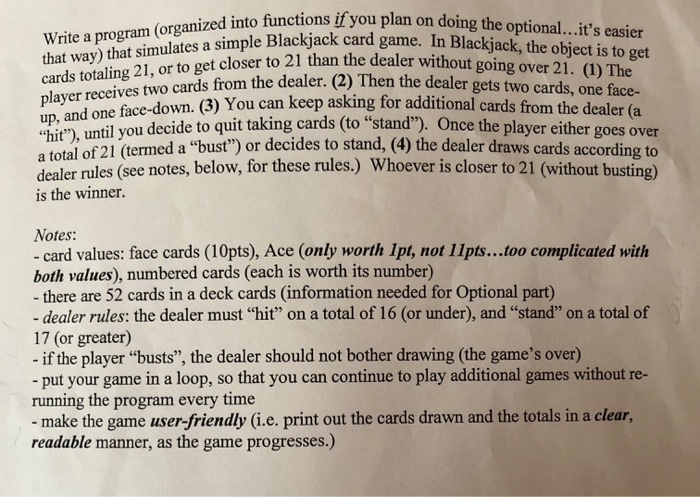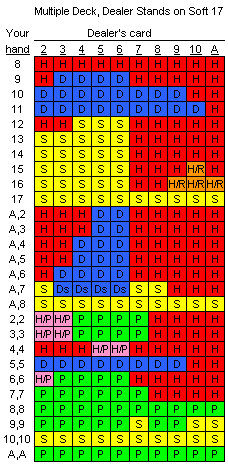Blackjack Rules Dealer Must Hit
The “soft 17 rule” is a rule that requires the dealer to hit on soft 17. For many blackjack players, this rather innocuous rule doesn’t seem like a big deal, but the fact of the matterHenry Tamburin is the editor and publisher of the Blackjack Insider Newsletter and author of the best-selling Blackjack: Take the Money & Run. He is also the lead Instructor for the Golden Touch Blackjack course, a feature writer for Casino Player magazine (and 6 other publications); an owner of a casino gambling publishing company (www.rsucasinobooks.com) and the host of www.smartgaming.com. For a free three month subscription to the Henry's Blackjack Insider Newsletter with full membership privileges go to www.bjinsider.com/free. Henry's website is www.smartgaming.com it is.
First, a quick review of what we mean by a soft hand. Any blackjack hand that contains an ace counted as an 11 is a soft hand. An ace-6 hand is a soft 17 and so is an ace-3-3 hand. These hands are played much differently than their corresponding hard hands. For example, ace-6 is soft 17 whereas 10-7 and 7-9-ace hands are hard 17’s (notice that if your hand contains either no ace, or one or more aces that are each count as one, the hand is hard). The reason the distinction is made between soft and hard hands is that they are played quite differently. For example, a player who is dealt a 10-7 should always stand whereas a player who is dealt an ace-6 should never stand.
In the world of blackjack some casinos require dealers to stand when their hand is a soft 17 (designated as s17), whereas others require dealers to hit soft 17 (i.e. they have implemented the soft 17 rule or h17). You can always tell whether a casino has the soft 17 rule or not by reading the wording on the table layout. If it reads “Dealer Must Stand on all 17’s” it means the dealer will stand on soft 17. If instead it states “Dealer Hits Soft 17”, it means the dealer will hit soft 17.
What happens to the odds when the soft 17 rule is in effect? Usually the dealer will bust more often which is good for the player. However, when he doesn’t bust, what would have been a 17 often ends up to be a higher hand that more often then not will beat the player’s hand. Overall the player’s net expectation is reduced by 0.20% with the soft 17 rule which is another way of saying the casino’s edge over a blackjack player increases by that amount. The soft 17 rule, therefore, favors the casino not the player.
The most common approach taken by novice players is to play their hands according to the same rules the dealer must follow—i.e., to hit until their hand achieves a total of 17 or greater—figuring that this gives them as good a chance at the house of winning each round. Common Rule: The dealer deals out two cards to himself at the beginning of the hand. The dealer immediately “peeks” to see if he has blackjack; if he does, it is revealed, and all player bets lose (except for blackjacks, which push). If he does not have blackjack, the hand continues as normal. The dealer must hit if the value of the hand is lower than 17, otherwise the dealer will stand. Whether or not the dealer must hit on a soft 17 (a hand of 17 containing an ace being counted as 11) differs from casino to casino. There might even be blackjack tables with different rules within the same casino.
Fortunately, there aren’t too many adjustments that you need to make to the basic playing strategy if you are playing in a game with h17. When you are playing, in general you should:
double down on 11 against a dealer’s ace
double down on soft 19 against the dealer’s 6
double down on soft 18 against the dealer’s 2
A more accurate set of playing strategy modifications that takes into effect the number of decks of cards being used is summarized below. Notice the additional hands that you should surrender with h17. The reason is because the player’s chance of winning these hands decreases enough with h17 compared to s17, that surrender becomes the better option.

Hit soft 18 against ace
If double after pair splitting is allowed, split a pair of 9’s against an ace
If surrender is allowed, surrender hard 15 against an ace and hard 17 against an ace.
Double down on soft 14 against 4
Double down on soft 18 against 2
Double down on soft 19 against 6
If surrender is allowed, surrender hard 15 against dealer ace.
4, 6 or 8 Decks
Double down on 11 against an ace
Double down on soft 17 against 2
If surrender is allowed, surrender hard 15 against ace, hard 17 against ace, and a pair of 8’s against dealer ace.
Unfortunately, the number of casinos that are switching to the soft 17 rule is increasing. I can remember not too long ago when nearly 100% of the strip casinos in Las Vegas had the s17 rule on their shoe games. That’s not the case anymore. Based on the information of blackjack playing conditions reported in Stanford Wong’s “Current Blackjack News” only 17% of the Strip casinos offer “only s17 games”, 40% “only h17”, and 43% a mix of s17 and h17 games. Also, just about all the casinos that cater to local players offer only h17 games and ditto for the majority of casinos located in the downtown area.
However, you shouldn’t judge a blackjack game solely on the h17 rule. Why? Because even though the casino gains an extra 0.20% with the soft 17 rule, many casinos in Las Vegas and elsewhere also give some of that edge back to the player by offering single or double deck games in lieu of 6 or 8 deck games. Throw in a few more player favorable rules, such as double after pair splitting (das), resplit of aces (rsa), or late surrender (ls), and all of a sudden a h17 game isn’t such a bad game after all.
For example, summarized below is the casino’s edge for typical blackjack games you will find in Las Vegas (this of course excludes those dastardly 6-5 single games which you should not play). . Note that the casino edge over a basic strategy player for a single deck game with h17 is only 0.18%, a good blackjack game by anyone’s standard. Compare that with the rather high 0.79% for the comparable 6-deck game. In fact even a h17, 6 deck game with a bunch of added player favorable rules still only makes the game average for basic strategy players by Vegas standards.

# Decks Rules Casino Edge
Single deck h17 0.18%
Single deck h17, rsa 0.15%
Single deck h17, das 0.06%
Double deck h17 0.53%
Double deck h17, rsa 0.48%
Double deck h17, das, rsa 0.35%
Double deck h17, das, rsa, ls 0.28%
6 deck h17 0.76%
6 deck h17, rsa 0.69%
6 deck h17, ls 0.67%
6 deck h17,das 0.63%

6 deck h17, das, rsa 0.56%
6 deck h17, das, ls 0.54%
6 deck h17, das, ls, rsa 0.46%
In northern Nevada most casinos offer single deck games with h17 but they restrict doubling to only hard 10 and 11. The latter is a casino player favorable rule that results in this game having a casino edge of 0.44% (ie. it converts a good blackjack game to at best average).
The bottom line is that the soft 17 rule is tolerable in a single deck game (with no restrictions on doubling) and also in a double deck game if das, rsa, or ls is offered. For 6 (or 8) deck games, given a choice between h17 or s17 game, you are better off playing a s17 game.
Once all the players have completed their hands, it is the dealer's turn. The dealer hand will not be completed if all players have either busted or received blackjacks. The dealer then reveals the hidden card and must hit until the cards total up to 17 points. At 17 points or higher the dealer must stay.
From everywhere, how many times does the dealer have to hit in blackjack?
Officially, the rules of blackjack are for the dealer to hit until he has 17 or more, regardless what the player(s) have (unless the players have all busted). Furthermore, in some casinos and in some formats of blackjack, a dealer will hit again on a 'soft 17' (i.e. an A and a 6).

Beside that, when should you hit on blackjack? When to hit in Blackjack In general, if you have a total of 8, you should hit against any card that the dealer holds. With so many 9 and 10-value cards in the deck, the chances of you making a good hand are high.
Incidently, what does it mean dealer must hit soft 17?
Hitting soft 17 gives the dealer the chance to make the 18, 19, 20 and 21 hands that can win on their own against a player pat hand. This comes into play most often when the dealer's face up card is an Ace and basic strategy players hit until they have 17 or better.
What if dealer and player both get blackjack?
If a dealer and a player both have blackjack the result is a push and the player's bet is returned. Any insurance bets are paid at 2:1. If the dealer does not have blackjack any insurance bets are lost and any players who have blackjack are paid. It is then the turn of the remaining players to take their actions.